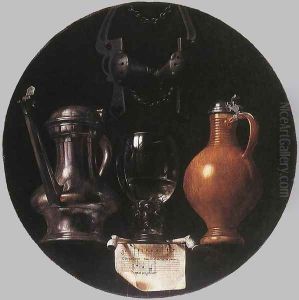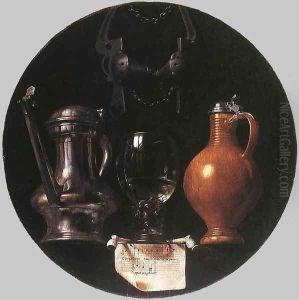Jan Symoonisz. (Johannes) Torrentius Paintings
Jan Symoonisz. (Johannes) Torrentius was a Dutch painter born in Amsterdam in 1589. His life and work are shrouded in mystery and controversy, largely due to his unorthodox lifestyle and the scant survival of his artworks. Torrentius was known for his exquisite and highly detailed still life paintings, a genre that was becoming increasingly popular in the Netherlands during his lifetime. However, it is his association with the Rosicrucians and accusations of heresy that have predominantly defined his historical legacy.
Torrentius's paintings, particularly his still lifes, were celebrated for their meticulous attention to detail and the use of light and shadow, which lent a nearly photographic quality to his work. This was at a time when the Dutch Golden Age was in its infancy, and artists were experimenting with new subjects and techniques, moving away from religious themes to focus on secular life, landscape, and still life. Despite the high regard in which his technical skills were held, very few of his works have survived, possibly due to the deliberate destruction of his art following his trial and imprisonment.
In 1627, Torrentius was arrested on charges of blasphemy, heresy, and atheism, primarily because of his alleged involvement with the Rosicrucians, a secret society that was frowned upon by the church and state authorities. His unconventional beliefs, coupled with his reputed libertine lifestyle, made him a target for the Calvinist church authorities. After a trial that attracted considerable attention, he was sentenced to 20 years of imprisonment. However, his sentence was reduced after intervention from Charles I of England, who became interested in Torrentius through the Dutch ambassador. Torrentius was released in 1630 and subsequently moved to England, where he lived under the patronage of the king. Little is known about his life in England, including whether he continued to paint.
Johannes Torrentius died in 1644, leaving behind a legacy that is more famous for its scandal and mystery than for its artistic contributions. Despite the scarcity of his surviving works, he is remembered as a unique and talented artist whose life story provides a fascinating glimpse into the cultural and religious tensions of 17th century Europe. His work, though largely lost to history, is considered a precursor to the later achievements of Dutch still life painting, marking him as a significant, if enigmatic, figure in the history of art.

